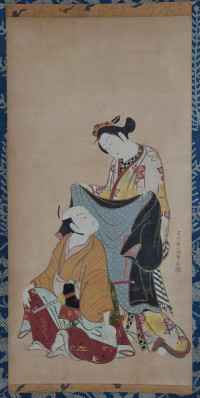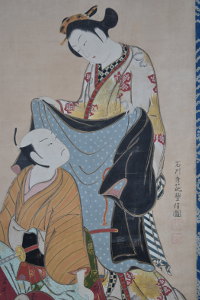Ishikawa TOYONOBU (1711-1785)

Click here to view image full size.
A very fine original painting, sumi and colour on paper with extensive laquer and a large emossed gold floral pattern on the bijin’s kimono; other areas in gold. Image size 35.25 x 17.75 in; 89.5 x 45 cms. Shows an elegant beauty holding up an haori to slip it over the shoulders of a seated nobleman. There is a great feeling of tenderness between the couple in this beautiful painting. In fact Toyonobu produced a print of this exact subject but showing the actors Nakamura Kiyosaburo I as Okiku and Ichimura Kamezo I as Kosuke, a pair of lovers, who were in the play Fujito nikki in 7/1751. Toyonobu must have liked the design and produced this painting but of just the protagonists. See this link in google
for the published print.
Toyonobu was a pupil of Nishimura Shigenaga and his style is also indebted to Okumura Masanobu. Produced some of the most exquisite kakemono-e, hashira-e and large obans of this period which, when they come onto the market, fetch considerable sums of money. (See, for example, Christies auction, N.Y., 18/9/2002, lot 6, ex Vever collection.) For a fine collection of his work, see The Clarence Buckingham Collection of Japanese Prints. The Primitives, 1955, A.I.C., pp. 199 – 229, nos. 1 – 58. Signed Ishikawa Shuha Toyonobu zu with seals Ishikawa uji and Toyonobu. Illustrated in colour in the exhibition catalogue of the Fuchu Art Museum, Artists of the Three Capitals-Learning About Edo Through Kyoto and Osaka, Kaneko, Nobuhisa, Oto, Yumiko, 2012, No. 67, p. 92. The cataloguing gives the play as Hiyoku no kagamon but this is most likely a dance that served as the finale. Hiyoku can mean “wings abreast” and hiyoku no tori, the “hiyoku birds” were a mythical couple who shared a single pair of wings, i.e. two lovers. In fine condition, especially given the age. Painted c. 1751.
Status: Sold

